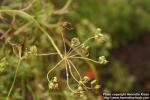Anisum (U. S. P.)—Anise.

 Related entries: Illicium (U. S. P.)—Illicium
Related entries: Illicium (U. S. P.)—Illicium
Preparations: Oleum Anisi (U. S. P.)—Oil of Anise
- Anise Water
- Spirit of Anise
"The fruit of Pimpinella Anisum, Linné"—(U. S. P.). (Anisum vulgare, Moench).
Nat. Ord.—Umbelliferae.
COMMON NAMES: Aniseed, Anise.
ILLUSTRATION: Bentley and Trimen, Med. Plants, 122.
Botanical Source.—Anise has a perennial, spindle-shaped, ligneous root, and smooth, erect, branched stem, 10 or 12 inches in height. The leaves are petioled; the radical ones roundish, heart-shaped, lobed, and cut serrated; the cauline ones biternate, with linear- lanceolate, rather cuneate-acuminate segments. The flowers are small and white, and borne in umbels on long stalks, and are 9 or 10-rayed, and naked; the partial ones have a few subulate, reflexed bracts. Calyx wanting or minute; corolla of 5 obovate, emarginate petals, with an inflexed lobe. Stamens 5, longer than the petals. The anthers are roundish, the styles subulate, spreading, long, and capitate. The fruit is ovate, 1 ½ lines long, dull-brown, slightly downy, not at all shining; half-fruits or mericarps with 5 filiform, equidistant, elevated ridges, sometimes rather wavy, and paler than the channels. The commissure is broad and flat (L).
History.—Anise originally came from Egypt, and is at present cultivated in many of the warm countries of Europe; the fruit of the Spanish plant is that which is more generally selected for medical purposes. The fruit, popularly called aniseed, is the official portion. Care must be taken not to confound any of the seed of the poisonous umbelliferous plants, as of the Conium maculatum, with those of the anise; a little attention will detect any accidental admixture of this kind, as the differences in the seed are well marked. The odor of anise is penetrating, and fragrant, and the taste aromatic and sweetish (P.). Water partially takes up its properties, alcohol wholly so; these are due to a volatile oil which may be procured by distillation of the fruit with water.
Description.—"About 4 or 5 Mm. (⅙ to ⅕ inch) long, ovate, compressed at the sides, grayish, finely hairy, and consisting of 2 each with a flat face, and 5 light-brownish, filiform ridges, and about 15 thin oil-tubes, which can be seen in a transverse section by the microscope. It has an agreeable, aromatic odor, and a sweet, spicy taste. It may be distinguished from conium fruit (which it somewhat resembles, and which has been mistaken for it), by the odor and taste, and by the conium fruit consisting usually of single mericarps, which are smooth, grooved upon the face, and have crenate ridges with wrinkles between them, and no oil-tubes"—(U. S. P.).
Chemical Composition.—A volatile oil is contained in the external coat of the seeds, while a green-colored, fat oil of a butyraceous consistency, is obtained by expression of their inclosed substance. Brandes obtained from the fruit of anise, concrete fixed oil, green fat oil, resin, nitrogenous matter, sugar, gum, bimalate and binacetate of calcium, bimalate of potassium, volatile oil, lignin, silicate of iron, water, gum-resin, phosphate of calcium, extractive with various salts, etc.
The star-anise of cordial manufacturers possesses a taste and odor similar to the anise, but is procured from the Illicium Anisatum, Loureiro, a plant growing in Eastern Asia. A volatile oil is obtained by distillation from its fruit, which is often fraudulently substituted for the oil of anise; it is called oleum badiani or oil of star anise. Oil of common anise is sometimes adulterated with spermaceti or camphor, to promote its solidification; the former may be known by its insolubility in cold alcohol, the latter by its odor.
Oil of anise yields, upon oxidation, anisic acid (C8H8O3=C6H4[OCH3]COOH). This acid occurs in the form of colorless crystals, insoluble in water, but freely soluble in alcohol. It is an oxidation product of anethol (C10H12O) (the chief principle of the oils of anise [94 per cent, Flückiger], star anise and fennel), obtained by fractional distillation of the oil of anise, reserving and purifying that fraction distilling from 230° to 234° C. (446° to 453.2° F.).
Action, Medical Uses, and Dosage.—A stimulant and carminative; used in cases of flatulency, flatulent colic of infants, and to remove nausea. Sometimes added to other medicines to improve their flavor, correct griping and other disagreeable effects. The dose of aniseed, crushed or powdered, is from 20 to 40 grains. Infusion (ʒij or ʒiij to aqua Oss.), for infants, in doses of a teaspoonful.
Derivatives.—ANISIC ACID is claimed to be antipyretic and antiseptic acting very much like salicylic acid, and has been employed with reputed success in articular rheumatism, and as a topical application to wounds. For internal use sodium anisate is preferred, the acid being but little used. Dose of the salt, 15 grains.

